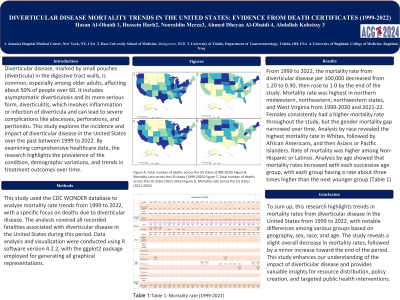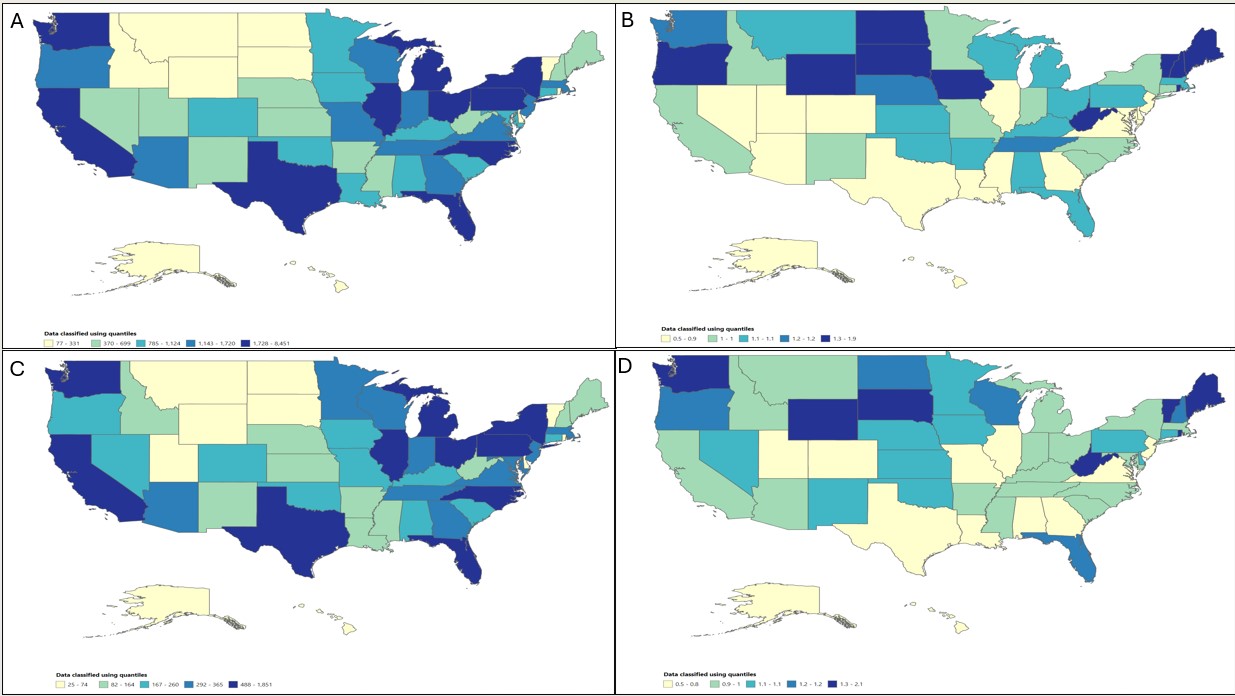Tuesday Poster Session
Category: Colon
P3648 - Diverticular Disease Mortality Trends in the United States: Evidence From Death Certificates (1999-2022)
Tuesday, October 29, 2024
10:30 AM - 4:00 PM ET
Location: Exhibit Hall E

Has Audio

Hasan Al-Obaidi, MD
Jamaica Hospital Medical Center
Briarwood, NY
Presenting Author(s)
Hasan Al-Obaidi, MD1, Hussein Harb, 2, Nooraldin Merza, MD3, Ahmed Dheyaa. Al- Obaidi, MBChB4, Abdallah Kobeissy, MD3
1Jamaica Hospital Medical Center, Briarwood, NY; 2Ross University School of Medicine, Brooklyn, NY; 3University of Toledo College Medicine and Life Sciences, Toledo, OH; 4University of Baghdad College of Medicine, Baghdad, Baghdad, Iraq
Introduction: Diverticular disease, marked by small pouches (diverticula) in the digestive tract walls, is common, especially among older adults, affecting about 50% of people over 60. It includes asymptomatic diverticulosis and its more serious form, diverticulitis, which involves inflammation or infection of diverticula and can lead to severe complications like abscesses, perforations, and peritonitis. This study explores the incidence and impact of diverticular disease in the United States over the past between 1999 to 2022. By examining comprehensive healthcare data, the research highlights the prevalence of the condition, demographic variations, and trends in treatment outcomes over time.
Methods: This study used the CDC WONDER database to analyze mortality rate trends from 1999 to 2022, with a specific focus on deaths due to diverticular disease. The analysis covered all recorded fatalities associated with diverticular disease in the United States during this period. Data analysis and visualization were conducted using R software version 4.2.2, with the ggplot2 package employed for generating all graphical representations.
Results: From 1999 to 2022, the mortality rate from diverticular disease per 100,000 decreased from 1.20 to 0.90, then rose to 1.0 by the end of the study. Mortality rate was highest in northern midwestern, northeastern, northwestern states, and West Virginia from 1999-2020 and 2021-22. Females consistently had a higher mortality rate throughout the study, but the gender mortality gap narrowed over time. Analysis by race revealed the highest mortality rate in Whites, followed by African Americans, and then Asians or Pacific Islanders. Rate of mortality was higher among Non-Hispanic or Latinos. Analysis by age showed that mortality rates increased with each successive age group, with each group having a rate about three times higher than the next younger group (Table 1).
Discussion: To sum up, this research highlights trends in mortality rates from diverticular disease in the United States from 1999 to 2022, with notable differences among various groups based on geography, sex, race, and age. The study reveals a slight overall decrease in mortality rates, followed by a minor increase toward the end of the period. This study enhances our understanding of the impact of diverticular disease and provides valuable insights for resource distribution, policy creation, and targeted public health interventions.

Note: The table for this abstract can be viewed in the ePoster Gallery section of the ACG 2024 ePoster Site or in The American Journal of Gastroenterology's abstract supplement issue, both of which will be available starting October 27, 2024.
Disclosures:
Hasan Al-Obaidi, MD1, Hussein Harb, 2, Nooraldin Merza, MD3, Ahmed Dheyaa. Al- Obaidi, MBChB4, Abdallah Kobeissy, MD3. P3648 - Diverticular Disease Mortality Trends in the United States: Evidence From Death Certificates (1999-2022), ACG 2024 Annual Scientific Meeting Abstracts. Philadelphia, PA: American College of Gastroenterology.
1Jamaica Hospital Medical Center, Briarwood, NY; 2Ross University School of Medicine, Brooklyn, NY; 3University of Toledo College Medicine and Life Sciences, Toledo, OH; 4University of Baghdad College of Medicine, Baghdad, Baghdad, Iraq
Introduction: Diverticular disease, marked by small pouches (diverticula) in the digestive tract walls, is common, especially among older adults, affecting about 50% of people over 60. It includes asymptomatic diverticulosis and its more serious form, diverticulitis, which involves inflammation or infection of diverticula and can lead to severe complications like abscesses, perforations, and peritonitis. This study explores the incidence and impact of diverticular disease in the United States over the past between 1999 to 2022. By examining comprehensive healthcare data, the research highlights the prevalence of the condition, demographic variations, and trends in treatment outcomes over time.
Methods: This study used the CDC WONDER database to analyze mortality rate trends from 1999 to 2022, with a specific focus on deaths due to diverticular disease. The analysis covered all recorded fatalities associated with diverticular disease in the United States during this period. Data analysis and visualization were conducted using R software version 4.2.2, with the ggplot2 package employed for generating all graphical representations.
Results: From 1999 to 2022, the mortality rate from diverticular disease per 100,000 decreased from 1.20 to 0.90, then rose to 1.0 by the end of the study. Mortality rate was highest in northern midwestern, northeastern, northwestern states, and West Virginia from 1999-2020 and 2021-22. Females consistently had a higher mortality rate throughout the study, but the gender mortality gap narrowed over time. Analysis by race revealed the highest mortality rate in Whites, followed by African Americans, and then Asians or Pacific Islanders. Rate of mortality was higher among Non-Hispanic or Latinos. Analysis by age showed that mortality rates increased with each successive age group, with each group having a rate about three times higher than the next younger group (Table 1).
Discussion: To sum up, this research highlights trends in mortality rates from diverticular disease in the United States from 1999 to 2022, with notable differences among various groups based on geography, sex, race, and age. The study reveals a slight overall decrease in mortality rates, followed by a minor increase toward the end of the period. This study enhances our understanding of the impact of diverticular disease and provides valuable insights for resource distribution, policy creation, and targeted public health interventions.

Figure: Figure A: Figure 1: Total number of deaths across the US states (1999-2020)
Figure B: Figure 2: Mortality rate across the US states (1999-2020)
Figure C: Figure 3: Total number of deaths across the US states (2021-2022)
Figure D: Figure 4: Mortality rate across the US states (2021-2022)
Figure B: Figure 2: Mortality rate across the US states (1999-2020)
Figure C: Figure 3: Total number of deaths across the US states (2021-2022)
Figure D: Figure 4: Mortality rate across the US states (2021-2022)
Note: The table for this abstract can be viewed in the ePoster Gallery section of the ACG 2024 ePoster Site or in The American Journal of Gastroenterology's abstract supplement issue, both of which will be available starting October 27, 2024.
Disclosures:
Hasan Al-Obaidi indicated no relevant financial relationships.
Hussein Harb indicated no relevant financial relationships.
Nooraldin Merza indicated no relevant financial relationships.
Ahmed Al- Obaidi indicated no relevant financial relationships.
Abdallah Kobeissy indicated no relevant financial relationships.
Hasan Al-Obaidi, MD1, Hussein Harb, 2, Nooraldin Merza, MD3, Ahmed Dheyaa. Al- Obaidi, MBChB4, Abdallah Kobeissy, MD3. P3648 - Diverticular Disease Mortality Trends in the United States: Evidence From Death Certificates (1999-2022), ACG 2024 Annual Scientific Meeting Abstracts. Philadelphia, PA: American College of Gastroenterology.
